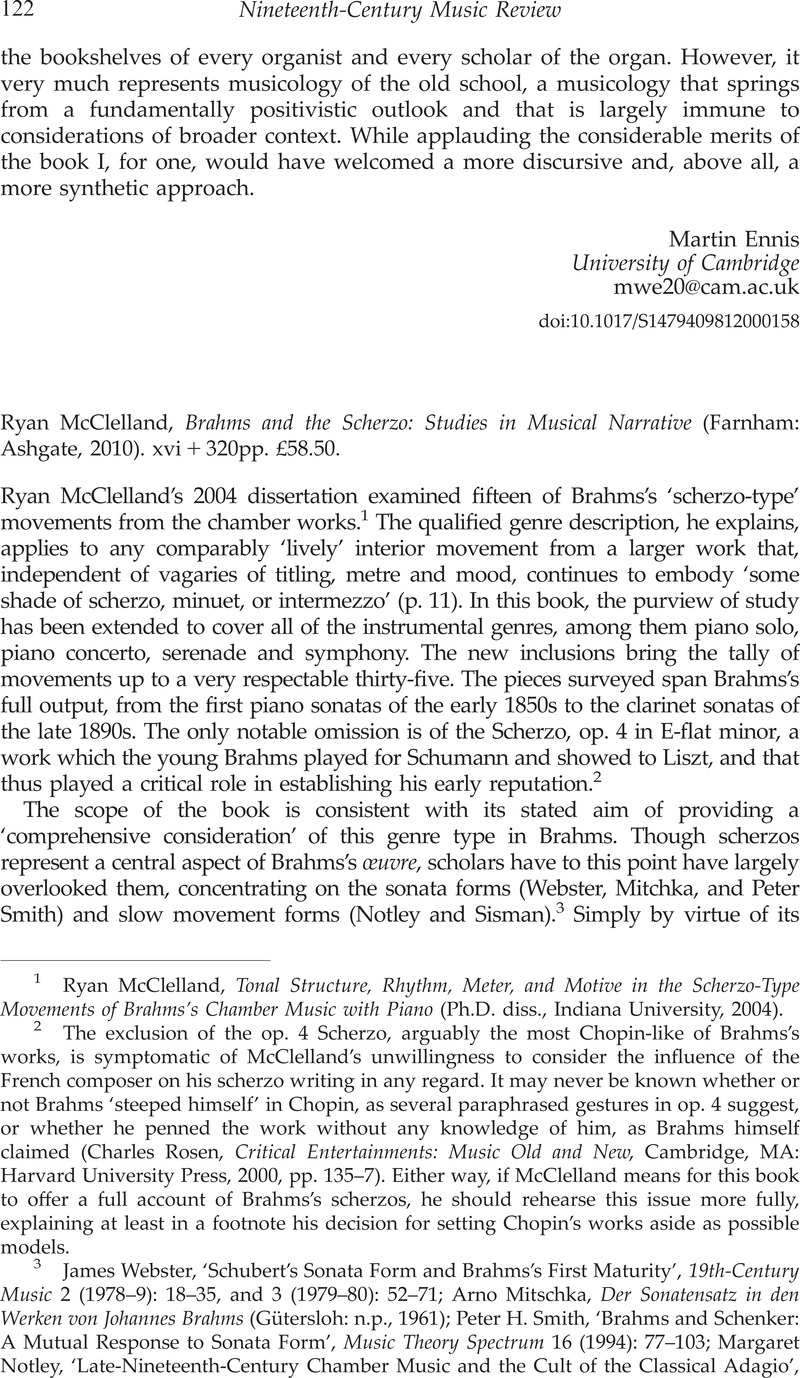No CrossRef data available.
Published online by Cambridge University Press: 24 May 2012

1 Ryan McClelland, Tonal Structure, Rhythm, Meter, and Motive in the Scherzo-Type Movements of Brahms's Chamber Music with Piano (Ph.D. diss., Indiana University, 2004)Google Scholar.
2 The exclusion of the op. 4 Scherzo, arguably the most Chopin-like of Brahms's works, is symptomatic of McClelland's unwillingness to consider the influence of the French composer on his scherzo writing in any regard. It may never be known whether or not Brahms ‘steeped himself’ in Chopin, as several paraphrased gestures in op. 4 suggest, or whether he penned the work without any knowledge of him, as Brahms himself claimed ( Charles Rosen, Critical Entertainments: Music Old and New, Cambridge, MA: Harvard University Press, 2000, pp. 135–137Google Scholar). Either way, if McClelland means for this book to offer a full account of Brahms's scherzos, he should rehearse this issue more fully, explaining at least in a footnote his decision for setting Chopin's works aside as possible models.
3 Webster, James, ‘Schubert's Sonata Form and Brahms's First Maturity’, 19th-Century Music 2 (1978–9): 18–35 CrossRefGoogle Scholar, and 3 (1979–80): 52–71; Mitschka, Arno, Der Sonatensatz in den Werken von Johannes Brahms (Gütersloh: n.p., 1961)Google Scholar; Smith, Peter H., ‘Brahms and Schenker: A Mutual Response to Sonata Form’, Music Theory Spectrum 16 (1994): 77–103 CrossRefGoogle Scholar; Notley, Margaret, ‘Late-Nineteenth-Century Chamber Music and the Cult of the Classical Adagio’, 19th-Century Music 23 (1999–2000): 33–61 CrossRefGoogle Scholar; Sisman, Elaine, ‘Brahms's Slow Movements: Reinventing the ‘Closed’ Forms’, in Brahms Studies: Analytical and Historical Perspectives, ed. George Bozarth (Oxford: Oxford University Press, 1990)Google Scholar:79–103.
4 His efficient system catalogues them tonally as continuous or sectional, melodically rounded or not, and allows for the possibility of a CRB(S) form, ‘a rounded binary design that has all of the thematic zones of sonata form’ (p. 15).
5 For more, see McClelland, Ryan, ‘Extended Upbeat in the Classical Minuet: Interactions with Hypermeter and Phrase Structure’, Music Theory Spectrum 28 (2006): 23–56 CrossRefGoogle Scholar.
6 Krebs, Harald, Fantasy Pieces: Metrical Dissonance in the Music of Robert Schumann (New York: Oxford University Press, 1999)CrossRefGoogle Scholar.
7 Almén, Byron, A Theory of Musical Narrative: Musical Meaning and Interpretation (Bloomington: Indiana University Press, 2008)Google Scholar; Hatten, Robert S., Musical Meaning in Beethoven: Markedness, Correlation, and Interpretation (Bloomington: Indiana University Press, 1994)Google Scholar; Maus, Fred, ‘Music as Drama’, Music Theory Spectrum 10 (1988): 56–73 CrossRefGoogle Scholar; Burnham, Scott, ‘How Music Matters: Poetic Content Revisited’ in Rethinking Music, ed. Nicholas Cook and Mark Everist (Oxford: Oxford University Press, 1999): 193–216Google Scholar.
8 See Almén, Theory of Musical Narrative, pp. 64–7Google Scholar, and Frye, Northrop, Anatomy of Criticism: Four Essays (Princeton: Princeton University Press, 1957)Google Scholar.
9 More specifically regarding point 2), the problem is less that a variety of types of metric dissonance are possible. It is more that McClelland neglects to establish even a general ranking among them. We are not informed what types of displacement and grouping dissonances, acting at what metric level, constitute ‘strong’ dissonances; we can only take the author at his word. This is in contrast to Krebs, who, in Fantasy Pieces, consistently charts pieces’ metric complexity directly in terms of the presence or absence of all relevant dissonance streams.
10 The term is described by Peter H. Smith as ‘A layering of structural parameters… typif[ied by] music of the tonal tradition’, wherein ‘individual strands of the total music fabric … function quasi-independently to yield multiple interpretive possibilities’. See his Expressive Forms in Brahms's Instrumental Music: Structure and Meaning in His Werther Quartet (Bloomington: Indiana University Press, 2005): 7.
11 Originally a conference paper, the work has since been published: see Samarotto, ‘Fluidities of Phrase and Form in the “Intermezzo” of Brahms's First Symphony’, Intégral 22 (2008): 117–143 Google Scholar.
12 In determining the hypermetre of movement II from Beethoven's Piano Sonata in E[flat], op. 27, no. 1, Schachter demonstrates the implied downbeat placement of suspension figures to be a critically important residue of tonality-implied metre. See his Unfoldings: Essays in Schenkerian Theory and Analysis (New York: Oxford University Press, 1998), 83–6.